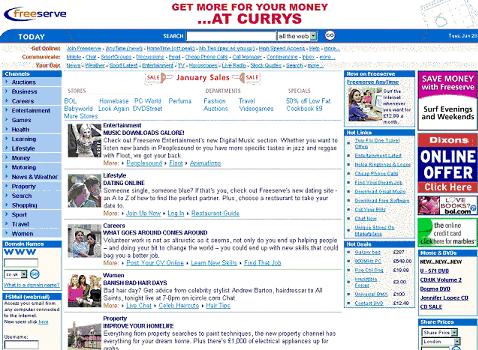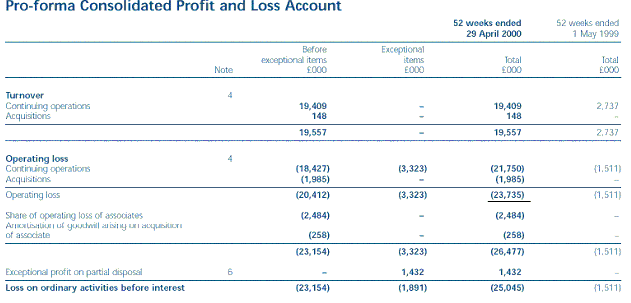








 |
Freeserve
Freeserve was launched in September 1998 by the Dixon
Group. It was the first ISP to offer subscription fee free Internet access
for the cost of local phone calls in the U.K..
Today its franchise has a 35% share of home Internet access
(approx. 3.5 million users).
On 2nd August 1999, after only ten months of
operation, Freeserve was listed on the London Stock Exchange and the
NASDAQ. The Dixon Group continues to own approximately 80% of Freeserve.
On 17th March 2000, Freeserve joined the FTSE 100 index of major UK
companies, employing only 200 people.
Today, Freeserve is also considered to be the largest
Business-to-Business (B2B) company on the World Wide Web and one that
pursues a very aggressive business strategy.

The following list emphasises how rapidly Freeserve has grown in only two
years and how aggressive their strategy is. The company today offers:
-
a free and simple narrowband Internet connection,
without a subscription fee including e-mail, 15 megabytes of personal Web
space and online 24 hour telephone support and two unmetered Internet
access propositions as well as broadband internet
-
a wide selection of
UK-focused e-commerce offerings, through shop@freeserve,
Freeserve Marketplace, iCircle,
and FSauctions
-
a variety of Internet tools
and services, including leading a search engine from Inktomi and
communications tools such as Speechmail, FSmail, e.notifier and Telserve
-
an ever broadening range of
community tools, including Smartgroups,
2-dimensional and 3-dimensional
chat, Web page building, forums, group calendars and e-mail
-
Clearlybusiness.com,
a portal for small businesses jointly developed by Freeserve and Barclays
PLC and coming soon, in joint venture with Bradford & Bingley Group, a
property channel featuring a searchable database of homes for sale,
financial services.
-
joint ventures for online
share trading (StockAcademy.com),
personal insurance (InsureanceWide.com) and motoring e-commerce (Fsmotorist.co.uk)

The homepage (www.freeserve.com)
is attractive with many links to all its sub-companies and a lot of
advertising, such that it seems confusing upon first sight. Subsidiary web
pages however, are very well structured and the contents bar is very
useful and one is able to find the relevant information quickly.
Furthermore, the structure is consistent throughout all the pages and is
easy to use as soon as one as grasped its information flourishing concept.
On Freeserve's pages one can find information
concerning, motoring, properties, actions, sports, e-commerce, online
shopping, travel, new, careers, entertainment, etc. The web page also got
it’s own reliable search engine which is fast and one is able get nearly
everything on Freeserve’s web pages what is nowadays offered on the web.
When registering with Freeserve one is also able to
customise his/her web page, which makes it consumer orientated i.e. user
friendly.
On the whole, the web page’s appearance, options
and structure are well designed. However, for the traditional home user
with a 56k modem, all the bandwidth consuming features like applets makes
surfing in their domain quite slow.


Freeserve became public listed on 2nd August 1999 and
the IPO was £1.50 per share, when Dixon released approximately 20% of its
shares. The flotation raised net proceeds of approximately £125 million
and the shares are traded in London on the main London Stock Exchange
(symbol FRE) and on the NASDAQ Stock Exchange (FREE). The current
(December 2000) share value is approx £2. However the shares price did
not increased steadily. It fluctuated strongly and was once valuated at £9.20
in March 1999. From this point onwards, the shares fell gradually and
fluctuated to today’s value.

It becomes evident from the graph that the stock
price didn’t evolve smoothly; it has a lot of peaks, which reflect the
vulnerability of the share. The following analysis will look at the main
stock market fluctuations of the share and give an explanation for those,
taking into account Freeserve’s financial performance, press release,
investor’s evaluation criterion and the theorem of stock market bubbles
into account.
At the beginning of December 1999 Freeserve’s share
price nearly doubled from £2.80 to £5.30 inside three days. The main
reason for this was the announcement of a strategic partnership with BT
Cellnet (genie.co.uk) to develop mobile Internet services. The press
release on the 2nd of December confirmed this and this further
increased the stakes by stating: ‘that
the leading edge of mobile Internet applications available today are just
the tip of the iceberg’. This information was apparently enough, at
that time, for the overconfident investors, who often are day traders,
i.e. speculators, to buy these shares. As only 20% of the shares were
available to the public, the demand for the shares was so great that a 95%
increase in share price occurred. However, the share price then fell again
by 20%, which proved the volatility of the share as the speculators
quickly sold their share due to the large yield. This share price, at that
time would not be classified as a typical stock market bubble due to this
important deal with BT and its economic value for the future of the
company.
In the middle of February 1999 the stock price rose
again by a 100% until the beginning of February. John Clare, chief
executive of Dixons Group declared on 12th
January that Freeserve is "not a pure ISP", and claimed that the
company is ahead of AOL in the move to provide content to
customers. The rise was not due to economic reasons, but due to his
statement and figures like 70% increase in Internet subscriber in the last
quarter and a 50% increase of the web page impressions. Apparently this
was enough evidence for investor to buy their shares. This rise fits the a
typical stock market bubble as the share value is hyped up only by soft
indicators like customer increase and turnover increase, however, not by
economic profit and the earnings to price ratio.
The stock price reached a peak at the 2nd
of May at a £9.20 and then the bubble burst. The share price started to
drop; the investors panicked and sold of their shares, which caused a
landside halving the share price within a week.
The exact reason for the offset of this crash has
several causes. Firstly, the overall stock market collapsed at this time
and Freeserve shares suffered due to this. The main part of this report
looks closely at what determines the overall market performs.
Secondly, investors, especially investment brokers/Banks might have
shifted their criterion for evaluating the share and taken the long-term
economic profit as a main criterion for the valuating the stock value.
This had not been very promising as the company made huge losses.
When investigating Freeserve's economic performance, the annual
report 1999/2000 revealed an operating loss of 23 million pounds (see
Operating loss). An increase of tenfold compared to the previous year.
Taking the P/E ratio as the main criterion for the stock market value
would therefore certainly justify the crash. It was probably the case that
investors lost faith in the long-term profitability of the company, and an
emphasis was placed on economic profit.


The market today is still very sceptical toward
Internet companies and Freeserve is now valued at about two pounds a
share. This is still 25% up on the issue value in August 1999. This seems
reasonable, as Freeserve has grown very quickly getting 3.5 million users
in less then two years and becoming the leading e-commerce site on the web
due to its overall aggressive strategy. These impressive figures caused
their early stock price increase. However, as analysts and investors took
their financial performance into account, the ‘bubble’ burst, giving
rise to the strong market correction, making today’s value more
appropriate. |